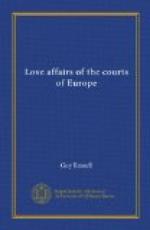Who was she, this woman of beauty and mystery? It was rumoured that she was a Circassian Princess, “the heroine of strange romances.” She was living luxuriously in a fine house in the most fashionable quarter of Paris, in company with two German “Barons”—one, the Baron von Embs, who claimed to be her cousin; the other, Baron von Schenk, who appeared to play the role of guardian. To her salon in the Ile St Louis were flocking many of the greatest men in France, infatuated by her beauty, and paying homage to her charms. To a man, they adored the mysterious lady—from Prince Ojinski and other illustrious refugees from Poland to the Comte de Rochefort-Velcourt, the Duke of Limburg’s representative at the French Court, and the wealthy old beau M. de Marine, who, it was said, placed his long purse at her disposal.
But while the men were thus her slaves, the women tossed their heads contemptuously at their dangerous rival. She was an adventuress, they declared with one voice; and great was their satisfaction when, one day, news came that the Baron von Embs had been arrested for debt and that, on investigation, he proved to be no Baron at all, but the good-for-nothing son of a Ghent tradesman.
The “bubble” had soon burst, and the attentions of the police became so embarrassing that the Princess was glad to escape from the scene of her brief triumphs with her cavaliers (Von Embs’ liberty having been purchased by that “credulous old fool,” de Marine) to Frankfort, leaving a wake of debts behind.
Arrived at Frankfort, the fair Circassian resumed her luxurious mode of life, carrying a part of her retinue of admirers with her, and making it known that she was daily expecting a large remittance from her good friend, the Shah of Persia. And it was not long before, thanks to the offices of de Rochefort-Velcourt, she had at her feet no less a personage than Philip, Duke of Limburg, and Prince of the Empire, one of those petty German potentates who assumed more than the airs and arrogance of kings. Though his duchy was no larger than an English county, Philip had his ambassadors at the Courts of Vienna and Versailles; and though he had neither courtiers, army, nor exchequer, he lavished his titles of nobility and surrounded himself with as much state and ceremonial as any Tsar or Emperor.
But exalted and serene as was His Highness, he was caught as helplessly in the toils of the Princess Aly as any lovesick boy; and within a week of making his first bow had her installed in his Castle of Oberstein, after satisfying the most clamorous of her creditors with borrowed money. That there might be no question of obligation, the Princess repaid him with the most lavish promises to redeem his heavily mortgaged estate with the millions she was daily expecting from Persia, and to use her great influence with Tsar and Sultan to support his claim to the Schleswig and Holstein duchies. And that he might be in no doubt as to her ability to discharge these promises, she showed him letters, addressed to her in the friendliest of terms by these august personages.




